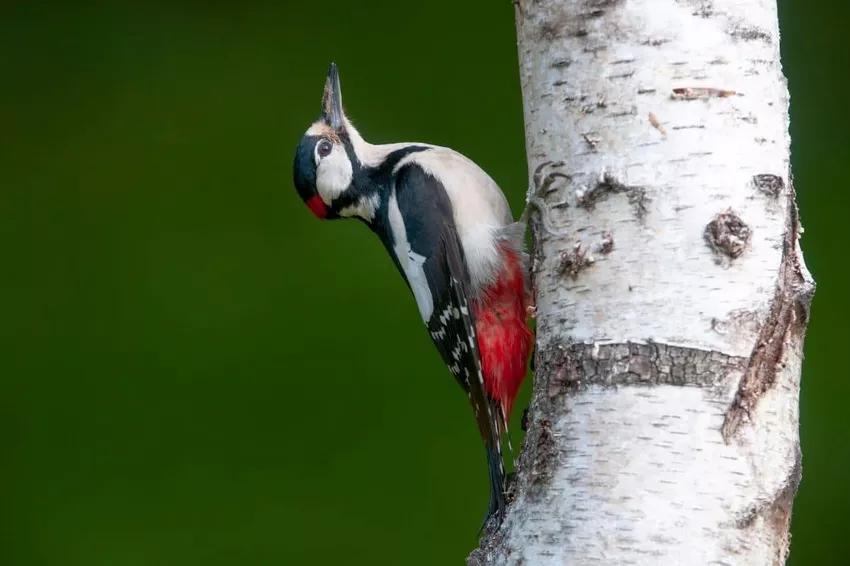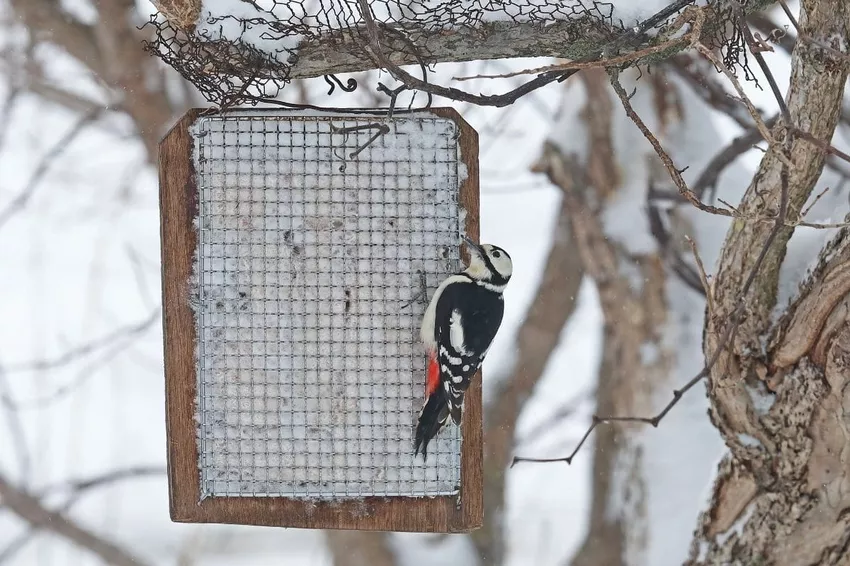- Skillful foraging
- Insects very popular
- He rings trees
- Support in winter
- Nutcracker
- Make your own fat feed
- frequently asked Questions

Great spotted woodpeckers are common in Germany. They are present all year round in deciduous and coniferous forests, parks, orchards and avenues. In winter, great spotted woodpeckers can also be found at feeding stations in the garden in search of food.
In a nutshell
- like to stay in trees, rarely on the ground
- eat insects and larvae living in the wood
- love the "ringing" of trees
- change their diet in winter
- belong to the group of mixed feeders
Skillful foraging
The Great Spotted Woodpecker (Dendrocopos major), up to 23 cm in size, with a white chest, typically white belly, red undertail and black back with white spots, mainly travels in trees when searching for food. He is rarely found on the ground. The wedge-shaped, strong beak, also known as the "chisel beak", is a great help. This allows the woodpecker to easily hit the wood with powerful blows. Not to be forgotten is the long tongue, which can be stretched forward by up to 40 mm.
Notice: The common spotted woodpecker is not acutely threatened. However, it is endangered in Central Europe in the long term, as the near-natural forests continue to decline.

Insects very popular
Insects living in wood and their larvae are the most popular food on the great spotted woodpecker's menu. With clever movements and strong beak strokes, he can easily pull them out from under the tree bark. In the wild, its food also includes:
- Worms, Caterpillars, Spiders
- ants, young beetles
- Berry
- nuts, beechnuts
- fruit
- Spruce and pine cones
- wild seeds
During the breeding season, the woodpecker quickly becomes a nest robber. It plunders the nests of tits and lesser woodpeckers in particular. He takes eggs and also young birds.
He rings trees
Great spotted woodpeckers also like to slurp tree sap and tree resin. To do this, it uses its beak to hack holes around the trunk or on the top of branches. He prefers to ring the trees in spring when they carry enough tree sap. The holes then slowly fill up with the juice and this is how the great spotted woodpecker gets this coveted food. Over time, the wounds or holes close by themselves (overflow) and the typical ring formation occurs. However, the rings sometimes look more like bulges. The woodpecker prefers:

- linden trees
- maple and
- red oaks
Notice: The great spotted woodpecker is considered to be a mixed feeder. In other words, in addition to soft food such as insects, fruit and dried berries, it also eats grains such as sunflower or pumpkin seeds, nuts, beechnuts, wild seeds and fatty food made from grains.
Support in winter
Especially in winter, when there is no longer a supply of insects, the woodpecker should be offered additional food at feeding stations in the garden. Very often you can see the birds there nibbling on tit rings. Sufficient fatty food is particularly important for the woodpecker during the cold season. Other feeds can also be offered to him. A change in diet is not difficult for the bird. The offer can be very generous, for example:
- nuts, beechnuts, acorns
- Fir and pine cones
- sunflower and pumpkin seeds
- cereal grains and oatmeal
- Seeds such as poppy, millet and flaxseed
- dried berries
- apples
- insect mixtures
- fatty food
Feeding columns filled with sunflower seeds or nuts are particularly suitable.
Nutcracker
It is no problem at all for the great spotted woodpecker to easily crack open hard-shelled food such as nuts or hard beetles. This takes place in the so-called “woodpecker forge”. In the forest, he jams the nut into a hole in the tree trunk that he had previously hacked for this purpose. Then he chops on the nut with his beak until the shell finally breaks. A little help can be given in the garden by removing the "drilling work". This option is particularly useful when the bird feeder has a thick, tall trunk. Of course a tree works too. The procedure is as follows:

- drill short holes
- Diameter at least 1 cm
- Put in the hazelnuts
- already cracked nuts also possible
- check the nuts every few days
- replace if necessary
- must not rot
Alternatively, nuts can also be clamped in branch forks. In addition, great spotted woodpeckers are also happy about pine and fir cones that are stuck in corresponding knotholes or bark crevices.
Tip: Even in winter, the birds need fresh water for drinking and bathing. A coaster with water should always be available. A hot plate can be of great help to keep it from freezing.
Make your own fat feed
Fatty food can also be made especially for woodpeckers without much effort.
- Melt 500g beef tallow or vegetable fat
- Add 2 to 3 tablespoons cooking oil
- Add double amount either:
- sunflower seeds
- nuts
- seeds
- dried fruits such as rowan or elderberries
- rosehips

Ingredients can also be mixed. Then everything has to cool down a bit. However, the mass should still be viscous. It is then smeared into the cracks in the tree bark. In this way they support the great spotted woodpecker in their search for food in their garden.
frequently asked Questions
Does the "drumming" have anything to do with foraging?Occasionally, these sounds are attributed to foraging. That's wrong. The great spotted woodpecker gives signals by “drumming”. On the one hand it defends its territory and on the other hand it is intended to attract either a male or a female.
How do woodpeckers hold on to trees when foraging for food?The woodpecker has so-called climbing feet with a turning toe. Depending on whether he climbs up or down the tree, the toe can rotate accordingly. In addition, a woodpecker has a strong supporting tail. This is a kind of third foot and provides sufficient security and support.
Can great spotted woodpeckers be lured into the garden?Yes there is a possibility. A suitable supply of food must be available for this purpose. Dead branches should also not be removed from trees. Here food can be found and a nest hole can be built. Of course, woodpeckers also like hanging nest boxes.